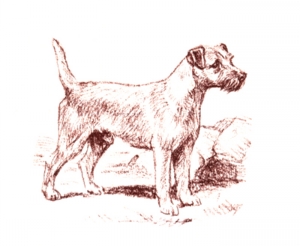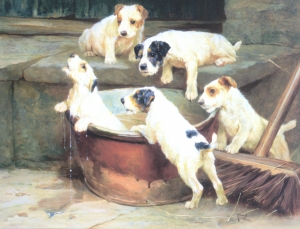Working Dog Instincts: They're a
Nuisance to the Pet Trade
The Seattle Times, July 15, 1990 DOGS
LOSING NATURAL ABILITY? By Ranny Green America's working, herding and hunting dogs are in trouble, says Richard Wolters, author of "Duck Dogs: All About Retrievers." But Corey McLennan, Edmonds canine behavioral consultant/trainer, believes Wolters' concern is misdirected. While Wolters claims hunting and working dogs are losing their natural ability to perform tasks for which they were originally developed, McLennan responds, "So what?" Wolters places the blame on breed popularity, which has resulted in certain breeds being bred for conformation and personality alone, sacrificing their natural hunting, herding and working capabilities. McLennan counters: "I deal with problems between dogs and their owners, and work to modify the animals' excessive barking, chewing, digging and destructiveness. These are most often a result of the natural instincts Mr. Wolters seeks to retain." For example, McLennan says, in Shetland sheepdogs barking was a highly desirable trait to aid in driving herds of livestock, the purpose for which the dog was originally developed. Today barking is considered a nuisance. In terriers, he explains, digging was looked upon favorably, since the dogs were called upon to ferret out rats and varmints from underground. Now, of course, digging is viewed as a problem. While McLennan admits he would like to see some genetic drives retained, he emphasizes, "There is very little value in breeding dogs for their original purpose because those skills are no longer required. "The majority of dogs in America are pets, not hunters, herders or ratters. Dogs with bloodlines that are more closely related to their original intent often find it difficult to adjust to normal family life today." Sporting dogs are among the most popular today. "A client of mine," McLennan says, "describes the ideal bird dog as so energetic that at the end of a full day of hunting, it looks up at you as you return to your car and says, 'C'mon, let's go one more!' But what does the dog do with all that energy the remainder of the year? In today's lifestyle of small yards, apartments and condominiums, that energy is misplaced and these dogs tend to become poor citizens. "The exceptions are the working dogs bred for their guardian abilities. With crime levels increasing, the need for sound dogs with guarding instincts is becoming more valuable." McLennan takes aim in another direction - the obedience ring. "A popular misconception is that a dog from a competition obedience background will make a good family pet. This is not always true." AKC obedience rules were developed to demonstrate the usefulness of the dog as man's companion. Recently, McLennan says, the focus of obedience training has changed, placing more emphasis on unerring precision and a brisk, flashy style in exercises. "A good competition dog that can stand up to the rigors of training is often an active and animated animal, displaying many of the same characteristics of a good hunting dog - a high energy level and willingness to work almost unceasingly. Again, while this dog is an excellent candidate for competition obedience, he may not adjust well to the less active lifestyle of the average family." One of the most common problems seen by McLennan is the mismatched dog and owner. This often is the result of an owner buying on impulse without checking the temperament and nuances of the breed. "Usually it's a matter of the dog coming home and developing into a more dominant, independent or active animal than the owner anticipated." The owner finds himself at his wits' end, usually pleading with an animal behaviorist for quick help or surrendering the dog at a nearby shelter. To avoid these volatile matchups, McLennan, among others, offers litter evaluation services to help clients determine the puppy best suited for them. This involves several simple tests, handling of the puppies and observing the interaction of the litter mates at 6 weeks of age and older. "A common scenario," says McLennan, is this: The entire family goes out to pick out the puppy. When they first meet the puppies, one runs up to greet everyone, jumping up and licking the children. This is the puppy that invariably goes home with them because 'he chose us.' This is usually the most active and dominant litter member that, as an adult, develops into a dog that is not appropriate for a family with children." ......................................................... Ranny Green write the "Pets" column in the The Seattle Times
|

